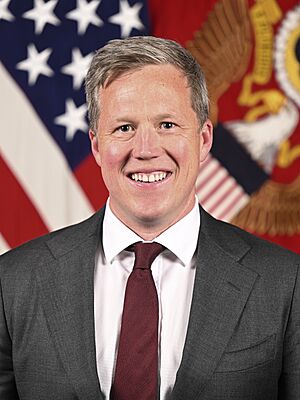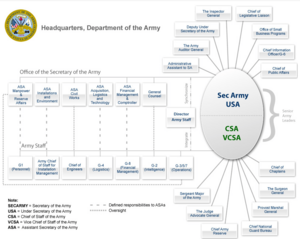United States Secretary of the Army facts for kids
Quick facts for kids United States Secretary of the Army |
|
|---|---|
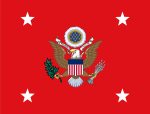
Flag of the secretary
|
|

Seal of the U.S. Department of the Army
|
|
| United States Department of the Army | |
| Style | Mr. Secretary |
| Reports to | United States Secretary of Defense |
| Appointer | President of the United States
with Senate advice and consent
|
| Term length | No fixed term |
| Precursor | Secretary of War |
| Formation | September 18, 1947 |
| First holder | Kenneth Claiborne Royall |
| Succession | 2nd in SecDef succession |
| Deputy | Under Secretary of the Army Chief of Staff of the Army |
| Salary | Executive Schedule, Level II |
The Secretary of the Army (often called SECARMY) is a very important civilian leader. This person works for the United States Department of Defense. They are in charge of almost everything related to the United States Army. This includes people, equipment, money, and military bases.
The President of the United States chooses who will be the Secretary of the Army. Then, the United States Senate must agree with the President's choice. The Secretary of the Army works under the Secretary of Defense. This job was created on September 18, 1947. It replaced the old Secretary of War position. This happened when the Department of War was divided. It became the Department of the Army and the Department of the Air Force.
Daniel P. Driscoll became the Secretary of the Army on February 25, 2025. He was sworn into office on that same day.
Contents
What the Secretary of the Army Does
The Army's top leaders include two civilians and two military officers. The civilians are the Secretary of the Army and the Under Secretary of the Army. The military officers are the Chief of Staff of the Army and the Vice Chief of Staff.
The Secretary of the Army is like the main boss of the Department of the Army. The Chief of Staff of the Army works directly for the Secretary. The Secretary explains the Army's plans and budgets to other leaders. This includes the Secretary of Defense and the Congress. They also tell the public about the Army's work and achievements.
The Secretary holds meetings with other Army leaders. They discuss important issues and make decisions. The Secretary is also part of the Defense Acquisition Board. This group helps decide what new equipment the military will buy.
The Secretary of the Army also has duties under the Uniform Code of Military Justice. This includes the power to start serious military court cases.
Offices Supporting the Secretary
The Office of the Secretary of the Army has many different parts. It includes the Under Secretary of the Army and several Assistant Secretaries. It also has other important roles. These include the administrative assistant and the general counsel. The inspector general and the chief of legislation are also part of this office.
Here are some of the key offices:
- Under Secretary of the Army
- Assistant Secretary of the Army (Acquisition, Logistics, and Technology) (in charge of buying new gear)
- Assistant Secretary of the Army (Civil Works) (handles projects like dams and waterways)
- Assistant Secretary of the Army (Financial Management and Comptroller) (manages the Army's money)
- Assistant Secretary of the Army (Installations, Energy and Environment) (looks after Army bases and environmental issues)
- Assistant Secretary of the Army (Manpower and Reserve Affairs) (deals with Army personnel and reserve forces)
- General Counsel of the Army (the Army's top lawyer)
- Administrative Assistant to the Secretary of the Army (helps with daily operations)
- Inspector General of the Army (checks for efficiency and honesty)
Each civilian leader in these offices works closely with a military officer. For example, the Assistant Secretary for Manpower and Reserve Affairs works with the Army G-1.
History of Secretaries of the Army
Kenneth Claiborne Royall was the last Secretary of War. He became the first Secretary of the Army in 1947. This happened when the National Defense Act of 1947 took effect. Gordon Gray was the last Army Secretary who was also part of the President's Cabinet. After him, only the Secretary of Defense held Cabinet status.
It is not required for a Secretary of the Army to have served in the military. However, many have been part of the United States armed forces. Secretary Stone (1989-1993) is the only one who served in a military outside the United States.
| This color means the person was serving in an acting role. |
| No. | Image | Name | Start | End | President(s) | |
|---|---|---|---|---|---|---|
| 1 | 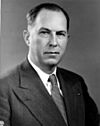 |
Kenneth Claiborne Royall | September 18, 1947 | April 27, 1949 | Harry S. Truman (1945–1953) |
|
| 2 | 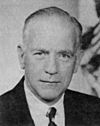 |
Gordon Gray | April 28, 1949 | April 12, 1950 | ||
| 3 |  |
Frank Pace | April 12, 1950 | January 20, 1953 | ||
| – | 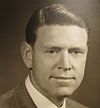 |
Earl D. Johnson Acting |
January 20, 1953 | February 4, 1953 | Dwight D. Eisenhower (1953–1961) |
|
| 4 | 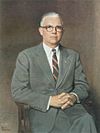 |
Robert T. Stevens | February 4, 1953 | July 21, 1955 | ||
| 5 | 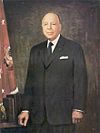 |
Wilber M. Brucker | July 21, 1955 | January 19, 1961 | ||
| 6 | 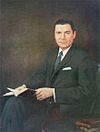 |
Elvis Jacob Stahr Jr. | January 24, 1961 | June 30, 1962 | John F. Kennedy (1961–1963) |
|
| 7 | 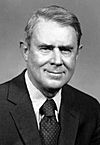 |
Cyrus Vance | July 5, 1962 | January 21, 1964 | ||
| Lyndon B. Johnson (1963–1969) |
||||||
| 8 | 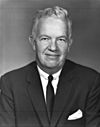 |
Stephen Ailes | January 28, 1964 | July 1, 1965 | ||
| 9 |  |
Stanley Resor | July 2, 1965 | June 30, 1971 | ||
| Richard Nixon (1969–1974) |
||||||
| 10 | 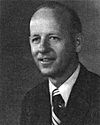 |
Robert Froehlke | July 1, 1971 | May 14, 1973 | ||
| 11 | 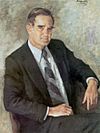 |
Bo Callaway | May 15, 1973 | July 3, 1975 | ||
| Gerald Ford (1974–1977) |
||||||
| – | 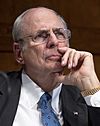 |
Norman R. Augustine Acting |
July 3, 1975 | August 5, 1975 | ||
| 12 | 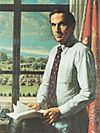 |
Martin Hoffmann | August 5, 1975 | January 20, 1977 | ||
| 13 | 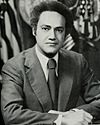 |
Clifford Alexander Jr. | February 14, 1977 | January 20, 1981 | Jimmy Carter (1977–1981) |
|
| – |  |
Percy A. Pierre Acting |
January 21, 1981 | January 29, 1981 | Ronald Reagan (1981–1989) |
|
| 14 | 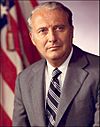 |
John Marsh | January 30, 1981 | August 14, 1989 | ||
| George H. W. Bush (1989–1993) |
||||||
| 15 |  |
Michael P. W. Stone | August 14, 1989 | January 20, 1993 | ||
| – | 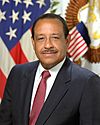 |
John W. Shannon Acting |
January 20, 1993 | August 26, 1993 | Bill Clinton (1993–2001) |
|
| – | 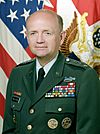 |
Gordon R. Sullivan Acting |
August 28, 1993 | November 21, 1993 | ||
| 16 | 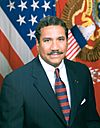 |
Togo D. West Jr. | November 22, 1993 | May 4, 1997 | ||
| – |  |
Robert M. Walker Acting |
December 2, 1997 | July 1, 1998 | ||
| 17 | 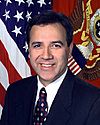 |
Louis Caldera | July 2, 1998 | January 20, 2001 | ||
| – |  |
Gregory R. Dahlberg Acting |
January 20, 2001 | March 4, 2001 | George W. Bush (2001–2009) |
|
| – |  |
Joseph W. Westphal Acting |
March 5, 2001 | May 31, 2001 | ||
| 18 | 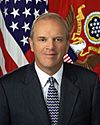 |
Thomas E. White | May 31, 2001 | May 9, 2003 | ||
| – | 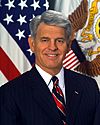 |
Les Brownlee Acting |
May 10, 2003 | November 18, 2004 | ||
| 19 | 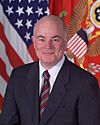 |
Francis J. Harvey | November 19, 2004 | March 9, 2007 | ||
| 20 | 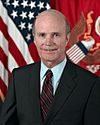 |
Pete Geren | March 9, 2007 | September 21, 2009 | ||
| Barack Obama (2009–2017) |
||||||
| 21 | 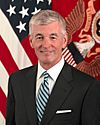 |
John M. McHugh | September 21, 2009 | November 1, 2015 | ||
| – | 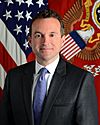 |
Eric Fanning Acting |
November 3, 2015 | January 11, 2016 | ||
| – | 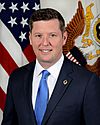 |
Patrick Murphy Acting |
January 11, 2016 | May 17, 2016 | ||
| 22 |  |
Eric Fanning | May 17, 2016 | January 20, 2017 | ||
| – | 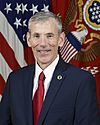 |
Robert Speer Acting |
January 20, 2017 | August 2, 2017 | Donald Trump (2017–2021) |
|
| – | 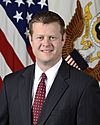 |
Ryan D. McCarthy Acting |
August 2, 2017 | November 20, 2017 | ||
| 23 | 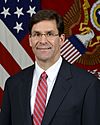 |
Mark Esper | November 20, 2017 On leave: June 24, 2019 – July 15, 2019 |
July 23, 2019 | ||
| – |  |
Ryan D. McCarthy Acting |
June 24, 2019 | July 15, 2019 | ||
| 24 | 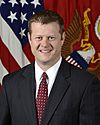 |
Ryan D. McCarthy | July 23, 2019 | September 30, 2019 | ||
| September 30, 2019 | January 20, 2021 | |||||
| – | 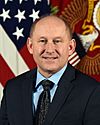 |
John E. Whitley Acting |
January 20, 2021 | May 28, 2021 | Joe Biden (2021–2025) |
|
| 25 | 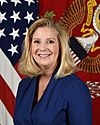 |
Christine Wormuth | May 28, 2021 | January 20, 2025 | ||
| – | 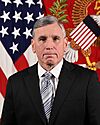 |
Mark Averill Acting |
January 20, 2025 | Incumbent | Donald Trump (2025–present) |
|
See also
 In Spanish: Secretario del Ejército de los Estados Unidos para niños
In Spanish: Secretario del Ejército de los Estados Unidos para niños


